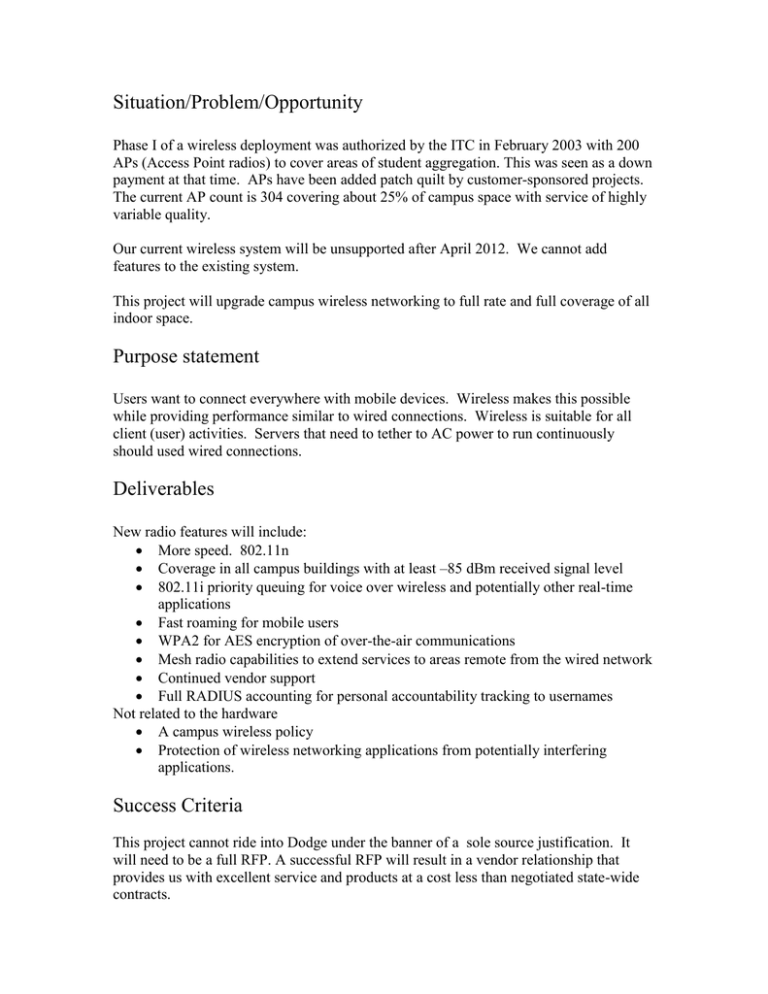wireless-project.doc
advertisement

Situation/Problem/Opportunity Phase I of a wireless deployment was authorized by the ITC in February 2003 with 200 APs (Access Point radios) to cover areas of student aggregation. This was seen as a down payment at that time. APs have been added patch quilt by customer-sponsored projects. The current AP count is 304 covering about 25% of campus space with service of highly variable quality. Our current wireless system will be unsupported after April 2012. We cannot add features to the existing system. This project will upgrade campus wireless networking to full rate and full coverage of all indoor space. Purpose statement Users want to connect everywhere with mobile devices. Wireless makes this possible while providing performance similar to wired connections. Wireless is suitable for all client (user) activities. Servers that need to tether to AC power to run continuously should used wired connections. Deliverables New radio features will include: More speed. 802.11n Coverage in all campus buildings with at least –85 dBm received signal level 802.11i priority queuing for voice over wireless and potentially other real-time applications Fast roaming for mobile users WPA2 for AES encryption of over-the-air communications Mesh radio capabilities to extend services to areas remote from the wired network Continued vendor support Full RADIUS accounting for personal accountability tracking to usernames Not related to the hardware A campus wireless policy Protection of wireless networking applications from potentially interfering applications. Success Criteria This project cannot ride into Dodge under the banner of a sole source justification. It will need to be a full RFP. A successful RFP will result in a vendor relationship that provides us with excellent service and products at a cost less than negotiated state-wide contracts. Continued or escalated growth, measured primarily by amount of traffic. Method/Approach Saying Let's do wireless is about as specific as saying Let's do transportation. You could mean roads, highways, freeways, trains, subways, airports... The system proposed here will provide performance that rates as "good". On this scale: Service from your neighbor down the street who let you use his AP is poor. Internet cafe service is fair to poor Home cable modem service with WiFi access and only one user rates as "good." A 100 Mb/s wired Ethernet port rates as "excellent." On this scale voice over WiFi users might have to walk toward the closest AP to get toll quality service. But the network will permit the call to work without dropping it. The approach is to deploy 2400 APs to cover 8.0M gross square feet with 802.11n service in the 5 GHz ISM band and 802.11g service in 2.5 GHz band. Resources This is a very large project. It will need a permanent technician and analyst FTE. And $3.4M. Risks/Dependencies There are a large number of volunteer APs (rogues) offering private WiFi services. Users need to be transitioned to the enterprise service. Alternately the private APs need to be promoted to the same level of security as the proposed system – which we see as unlikely. IDM may not be ready in time. Enterprise authentication services may remain an elusive target. Project resources (money) may become available for state-funded space and residential space at different times. Appendix Space from the LRDP: Now: Residential 2.0 M GSF Acad+support 2.8 M GSF ----4.8 M 2020: Residential 3.2 M GSF Acad+support 4.8 M GSF -----8.0 M Basic Internet access needs -80 dBm of RF signal Full Internet access requires -80 dBm of RF signal VoIP wifi coverage requires -65 dBm Coverage per AP Open office VoIP grad service 2500 SF Full internet access 5000 SF Basic internet access 10000 SF Russ' 50 ft rule APs at every position APs at every other position Small rooms 2500 SF 4000 SF 8000 SF Residential steel pan strips 2000 SF 2500 SF 5000 SF 2000 SF 8000 SF Examples of over subscription ratios that drive AP density Best effort service Web and email Production file transfer (YouTube) Wireless VoIP Sporadic video download Unbuffered video streaming 60:1 40:1 10:1 8:1 5:1 1:1 Assumptions: nothing stupid, so 1. no foil on insulation in interior walls 2. no leaky microwave ovens 3. no ISM band cordless phones, baby monitors, etc 4. "Residential steel pan strips" -- Residential buildings tend to be about 40 ft wide which "wastes" available range of AP radios located in the corridor -- reducing covered area by 2X because half the coverage circle is outside the bldg envelope. The steel-pan assumption is that there is no coverage from one floor to the next. This will be a worst-case assumption for coverage. 5. All new construction will include wiring for APs. Existing space will need new jacks estimated at our standard rate. This assumes new wireless jacks will be "all new" and not stolen room outlets. For Full Internet Access: Assumed average background noise and interference Access Point Transmit Power AP antenna gain AP Connector loss (integrated antenna) AP EIRP -95 dBm 30 mW 2.2 dBi 0 dB 16.8 dBm (48 mW) Client Device transmit power Client antenna gain 30 mW 2.2 dBi Client connector loss (integrated antenna) Client EIRP 0 dB 16.8 dBm (48 mW) RSSI minimum Signal-to-Noise ratio Min modulation rate Coverage Cell overlap boundry Fade Margin -80 dBm 15 dB 11/12 Mb/s -77 dBm 10 dB For Voice-over-IP, all is the same except: RSSI minimum Signal-to-Noise ratio Min modulation rate Coverage Cell overlap boundry Fade Margin -65 dBm 25 dB 54 Mb/s -62 dBm 10 dB ============== Notes: WiFi will convert from 2.5 GHz to 5 GHz when it switches from 802.11g to 802.11n. While penetration of interior sheetrock walls will remain good, concrete floors will be somewhat more opaque. We need to get it into our standards that interior walls should not have metal foil on insulation. We also want to limit metallic coatings on windows to south facing glass. This has more to do with cell phone coverage. The FCC prevents us from making spectrum utilization rules in the campus residential areas. We can make rules for our employees. 802.11g wap WAP wap-power jack central controller 802.11n old space $450 100 300 150 650 100 591 100 30 138 install (labor) 100 coverage survey (helium) 100 WCS (no location) 50 WCS (w/location) +25 ----$1250 WISM router slot 45 25 ----$1679 2.8 M GSF 2.0 M GSF 700 APs 800 APs LRDP addition A+A space: LRDP additional Resnet space: 2.0 M GSF 1.2 M GSF 500 APs 480 APs Total = $3.4M 650 100 100 30 138 45 35 ----$1070 Existing Academic+Admin space: Existing Resnet space: Wiring already in place $175,000 802.11n new space



